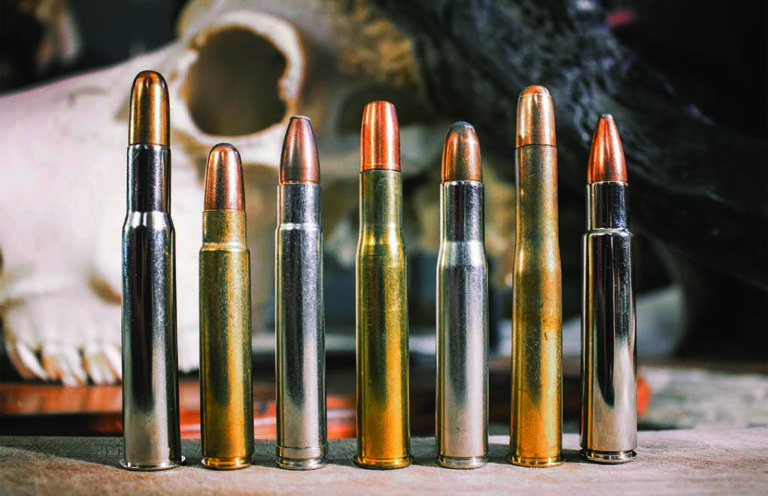

For the lovers of truly big bores, .40-caliber cartridges can provide the perfect balance.
What Are The .40-Caliber Rifle Cartridges:
.405 Winchester
.450-400 3-Inch Nitro Express
.400 H&H Magnum
.416 Rigby
.416 Remington Magnum
.416 Weatherby Magnum
.416 Ruger
.416 Taylor
.500-416 Nitro Express
.404 Jeffery
.425 Westley Richards
Hunting dangerous game requires a cartridge of substantial size, one powerful enough to handle those species that have the potential to turn the tables. There are those who find the lighter cartridges—the 9.3mms and .375s—to be the pinnacle of versatility, because they offer trajectories similar to some of the popular deer cartridges, such as the .308 and .30-06, yet carry enough horsepower to handle even the largest game.
And then there are those who feel that anything smaller than the .500 Jeffery or .500 Nitro Express is a waste of time, because no smaller cartridge could possibly stop a charge. I feel that somewhere in the middle lies the best balance of trajectory, striking power and ease of shooting—those lower .40-caliber cartridges.
Yes, the .various .450s , .470s, .475 and their clones work great. After all, the .450 Nitro Express set the benchmark for dangerous-game cartridges—but their trajectories give up a considerable amount to those lower .40s. And, in comparison to the .375s and 9.3mms, the bullet weight (along with correlative energy) of these lower .40s makes a definite difference when it comes to penetration.
Am I suggesting that cartridges such as the revered .375 H&H Magnum aren’t sufficient for dangerous-game hunting? No sane gun writer would ever put those words in print, and I’m a longtime proponent of the .375. But even with the 350-grain Woodleigh Weldcores, the .375 H&H doesn’t quite hit as hard as the .40s do.
Here’s the crop of the lower .40-caliber cartridges, including their strengths and weaknesses.
.405 Winchester
Starting with the least potent of the lot, the .405 Winchester is a straight-walled cartridge released in the Model 1895 Winchester lever-action rifle. It was a particular favorite of Theodore Roosevelt, who dubbed it his “medicine gun” for lions.
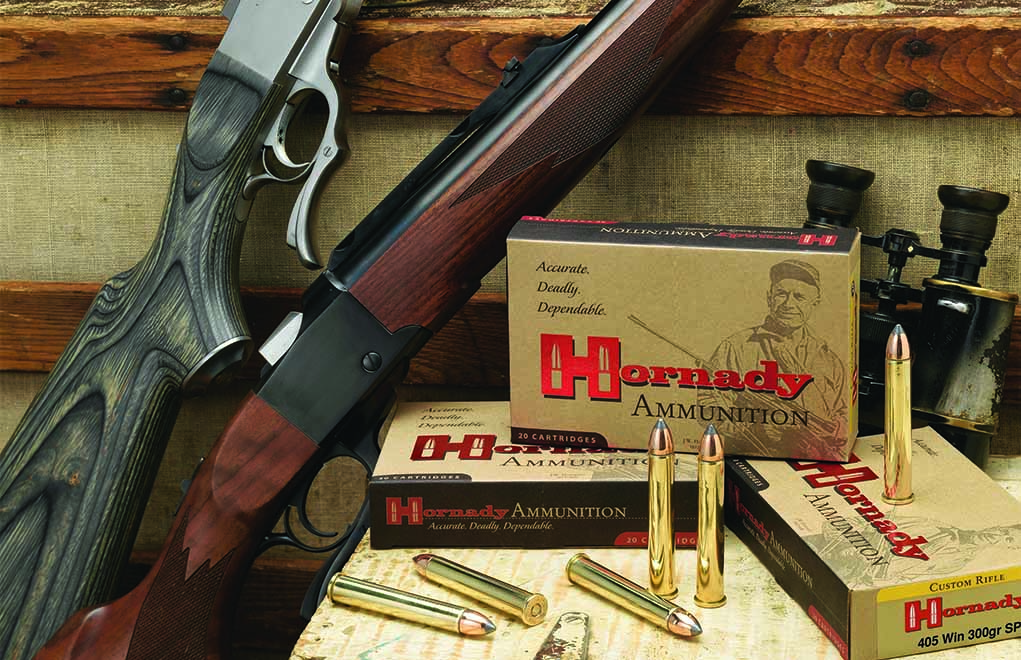
Launching a 300-grain, .411-inch-diameter bullet at 2,200 fps for slightly more than 3,200 ft-lb of muzzle energy, the .405 Winchester is definitely light, especially in comparison to the .375 H&H with heavy bullets. Roosevelt used this .40-caliber on lions and other game on his 1909–1910 safari and obviously lived to tell the tale, but I’m of the opinion that there are much better choices.
.450-400 3-Inch Nitro Express

The .450-400 (the British naming system uses the parent cartridge first) has gone through several iterations, at various lengths (2 3/8 inch, 3 inch and 3¼ inch) and has been fueled by black powder and smokeless alike. The 3-inch variant has been the most popular with many new double rifles, as well as the Ruger No. 1 single-shot, with ammunition produced by Hornady.
Using a .410-inch bullet, the classic .450-400 3-inch load consisted of a 400-grain bullet at 2,050 fps for 3,732 ft-lb of energy. While its paper ballistics indicate that the .375 H&H 300-grain load has more energy (4,263 ft-lb. vs. 3,732 ft-lb), the heavier bullet weight of the .450-400 gives it an advantage in the field.
The old .40-caliber cartridge (released in 1902) was used by Jim Corbett for tiger and leopards in India, as did John “Pondoro” Taylor in Africa. I used this excellent cartridge for a handsome Cape buffalo in Mozambique. It remains a great choice for a light-recoiling double-rifle cartridge capable of handling all game, including elephant. The .450-400 3-inch is also known as the .400 Jeffery.
.400 H&H Magnum
An obscure offering from Holland & Holland, this .40-caliber is usually revered by its users. Based on the belted .375 H&H case, using an 8-degree shoulder and the .411-inch-diameter bullets of the .450-400, the .400 H&H hasn’t really caught on. Yet, pushing a 400-grain bullet to 2,375 fps is a recipe that’ll most certainly have great success in the field. While I think the ship has sailed, there’s nothing wrong with using a .400 H&H for all dangerous-game hunting.
.416 Rigby

An undeniable classic, the .416 Rigby was released in 1911. Although fewer than 200 rifles were made up until World War II, the writings of Robert Ruark and John Taylor immortalized the cartridge. Simply put: The 410-grain bullet of nominal diameter at 2,370 fps (modern loads use a 400-grain bullet at 2,350 or 2,400 fps) offered more than 5,000 ft-lb of muzzle energy—and virtually unequaled penetration—due to the high sectional density.
Kenyan professional hunter Harry Selby procured a Rigby rifle in .416 Rigby when his .470 double was accidentally run over, and Robert Ruark’s Horn of the Hunter made both the man and cartridge famous. The .416 Rigby is a huge rimless case with a 45-degree shoulder. The case volume is a direct result of the volatility of cordite in the African and Indian heat in order to keep pressures low.
Its recoil, while higher than that of the .375 H&H, is manageable in a well-fitting rifle. And although the volume of the .40-caliber's case is more than is probably needed with our modern powders, the pressures are low—and that isn’t a bad thing. The .416 Rigby is a flat-shooter, yet it hits like a freight train. To fit properly, a magnum-length receiver should be employed.
Rigby has recently announced the release of the .416 Rigby No. 2, a rimmed version of the classic .416 Rigby that’s built for double-rifles. It shares the same geometry (except for the rim), and its ballistics are nearly identical.
.416 Remington Magnum
The 1980s saw a revival of the .416-inch-bore diameter: Federal brought back the .416 Rigby, and Remington introduced its .416 Remington Magnum, which is officially based on its 8mm Remington Magnum case (but the .40-caliber more than resembles the wildcat .416 Hoffman). Using the belted .375 H&H case as a platform, the .416 Remington Mag duplicates the ballistics of the .416 Rigby, but in a smaller diameter case and at a higher pressure.
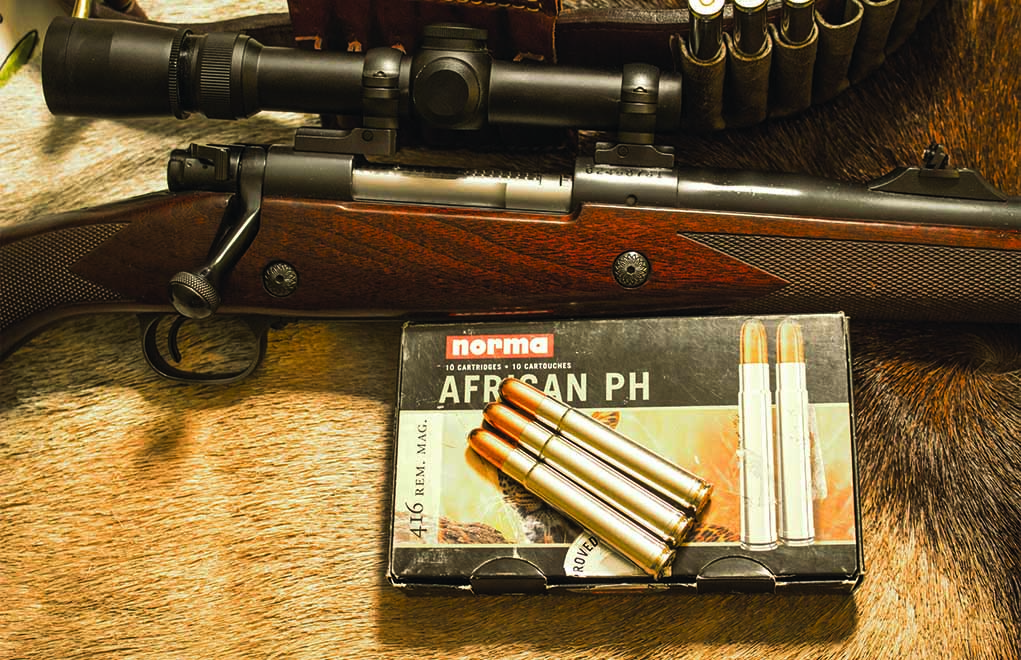
The cartridge received some negative press early on, but in a high-quality, controlled-round-feed action, this cartridge is nothing shy of amazing. With the exception of those who’ve handloaded the Rigby case to the red zone, the Remington variant will match the performance of the older cartridge. Yes, its belt is unnecessary; and yes, the pressure is higher than some shooters like, but in the field, I doubt any animal could ever tell the difference between a Rigby and Remington. It shares the same case length as the .375 H&H and fits perfectly in a magnum-length action.
Living Large With Big-Bore Rifles:
- Choosing A Big-Bore Cartridge And Rifle
- Big-Bore AR Evolution Is Larger Than Life
- Big-Bore Lever-Action: Steel Henry .45-70 Is Golden
- The Big, Big Bore: .450 Bushmaster
- Reloading Dangerous Game Cartridges: Life in the .40s
.416 Weatherby Magnum
It was 1989 when Weatherby adapted its big, double-radius case to the .416-inch bore, with the signature increase in velocity in tow. Weatherby’s .416 will push a 400-grain bullet to 2,700 fps, with a correlative recoil level. Of the .416s, I’d say the Weatherby is the least popular, although as with many of its other cartridges, its fans are fervent. With premium bullets, the .416 Weatherby will certainly handle any game that walks the Earth.
.416 Ruger
In 2008, the joint effort between Hornady and Ruger was expanded to include the .416 Ruger—a beltless case designed to fit in a long-action receiver, matching the velocity of the Rigby and Remington cases. Chambered in the Ruger Hawkeye African rifle, the .416 Ruger is affordable, effective and, for reasons I can’t quite explain, remains an unpopular choice.
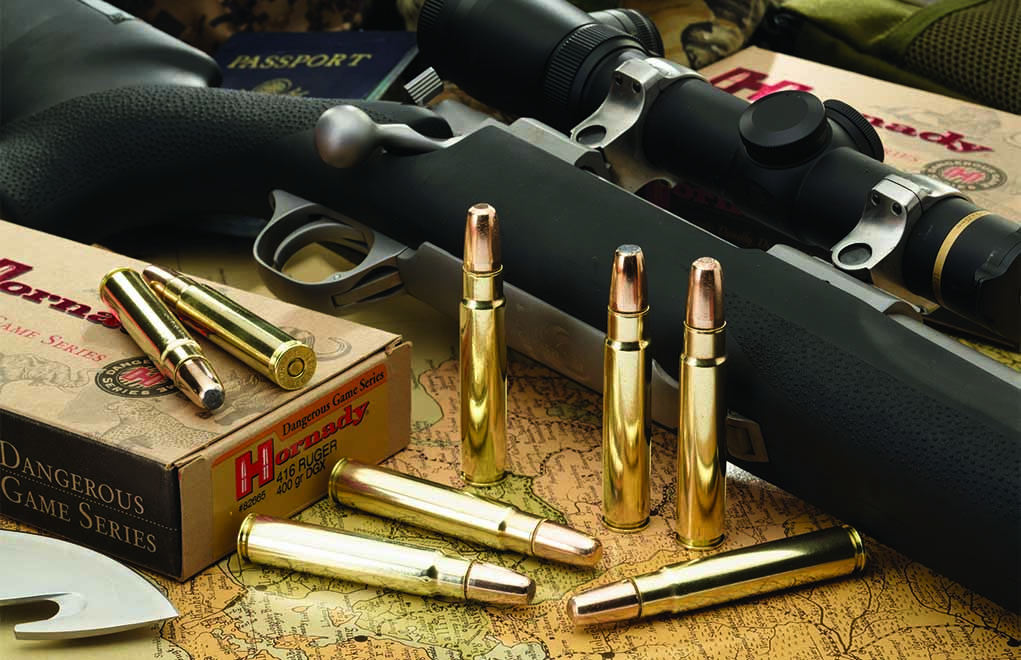
The design is certainly sound: In both factory ammunition and handloaded stuff, I’ve seen nothing but good results from the .416 Ruger. Even so, perhaps it’s the fact that only Hornady provides ammunition; or perhaps the .40-caliber lacks the “look” of power. Nevertheless, rest assured that the .416 Ruger brings the goods.
.416 Taylor
A wildcat based on the .458 Winchester Magnum and necked down to hold .416-inch bullets, the .416 Taylor is a solid design. DoubleTap has offered factory ammo for it in the past, but it remains a handloaded proposition. However, the .416 Taylor (developed in the 1970s by Bob Chatfield-Taylor) will come close to the Rigby benchmark, driving a 400-grain bullet to 2,350 fps. Donor brass is readily available; and, with a good set of dies, you end up with a belted case that fits perfectly in a long-action receiver.
.500-416 Nitro Express
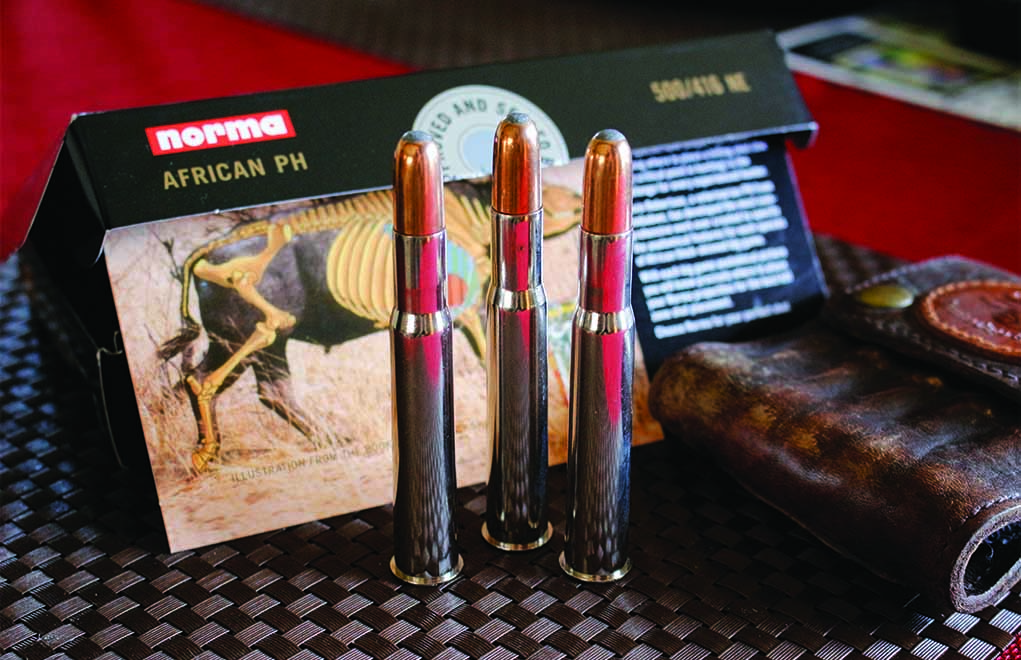
This modern rimmed case from Krieghoff uses a 3¼-inch case to push a 400-grain, .416-inch bullet to 2,300 fps and makes a solid choice for a hunter who wants a double-rifle in .40-caliber. Compared to the venerable .450-400 3-inch NE, it has a definite advantage in terminal ballistics and an increase in recoil. Popular in the Krieghoff doubles, the .500-416’s popularity has waned as of late; and, with the introduction of the .416 Rigby No. 2, I expect that trend to continue.
.404 Jeffery

This has become my personal favorite of the lot. According to the best evidence available, it was released in 1905, and although the .416 got the glory, the .404 did the work. The .404 Jeffery uses a 400-grain bullet of .423-inch diameter, with the original load leaving the muzzle at 2,150 fps and modern loads ramping up that figure to 2,350 fps. This puts it in the same league as the .416 Rigby, Remington and Ruger.
Modern bullets have made this .40-caliber even better. If I were forced to pick a single cartridge-and-bullet combination for all my dangerous-game work, it’d be my .404 Jeffery, loaded with 400-grain Woodleigh Hydrostatically Stabilized Solids to 2,280 fps. This combination has accounted for elephant, buffalo and all sorts of plains game animals at ranges from 16 to 225 yards.
.425 Westley Richards
The .425 Westley Richards came onto the scene in 1909, using a .435-inch-diameter, 410-grain bullet at 2,350 fps for slightly more than 5,000 ft-lb of muzzle energy. The design used a severely rebated rim in order to use the standard .473-inch bolt face of the 98 Mauser, as well as the stripper clips to facilitate fast reloading.
The issue posed by the rebated rim was the tendency for the bolt face to ride over the rim and onto the case body, causing a feeding malfunction. While it’s a unique cartridge, the .425 isn’t incredibly popular, and Kynoch is the only ammunition provider … when this ammo is available.
Compare and Contrast
Looking at the performance level among the .375s, lower .40s and the .45s, using 300-, 400- and 500-grain bullets, respectively, you’ll see the trajectories of the .40-calibers staying very close to that of the .375s, where the .45s drop off quite a bit more.
Yes, the .45s have more weight and a greater frontal diameter, but the energy figures between the lower .40s and the .45s aren’t radically different: They both have roughly 1,000 more ft-lb at the muzzle than do the .375s. And, I’ve found there’s a definite ramp-up in recoil when you go to the 500-grain, .45-caliber cartridges, which run at 2,150 fps and upward.
The beauty of the .375s is found in the wide selection of bullet weights (235 to 350 grains). However, the .40s aren’t exactly married to the 400-grain bullet—although it’s the most popular. There are bullets for these cartridges ranging from 300 to 450 grains.
Sectional Density
The classic cartridges—those that made their reputations before World War II during the “golden age of the safari”—all used a bullet with a sectional density greater than 0.300. While our modern bullet construction has lessened that requirement, the premium bullets of traditional weight extend the performance of these cartridges.
The 400-grain bullet for the .450-400 3-inch—the smallest diameter of the lot—has a sectional density of .340. The 410-grain .425 Westley Richards bullet—the largest—has an SD of .310. All have the desired length for a proper dangerous-game cartridge.
Choosing Yours
The choice of one of these .40-caliber cartridges is as subjective as choosing a deer cartridge. Of the cartridges listed, each has their merits. The .416 Rigby and .416 Remington are the most popular, followed by the .404 Jeffery. In spite of its lower velocity, the .450-400 3-inch remains the most popular of the rimmed cartridges—although I predict the .416 Rigby No. 2 will gain ground over the next decade.
If it’s affordability and availability that concerns you, the .416 Remington might be the best value. However, I’ve become enamored of the .404 Jeffery. But with the exception of that .405 Winchester, any of these cartridges will make you a happy hunter.
Editor's Note: This article originally appeared in the May 2020 issue of Gun Digest the Magazine.

Next Step: Get your FREE Printable Target Pack
Enhance your shooting precision with our 62 MOA Targets, perfect for rifles and handguns. Crafted in collaboration with Storm Tactical for accuracy and versatility.
Subscribe to the Gun Digest email newsletter and get your downloadable target pack sent straight to your inbox. Stay updated with the latest firearms info in the industry.

![Best Concealed Carry Guns In 2025 [Field Tested] Wilson Combat EDC X9S 1](https://gundigest.com/wp-content/uploads/Wilson-Combat-EDC-X9S-1-324x160.jpg)


![Best 9mm Carbine: Affordable PCCs [Tested] Ruger Carbine Shooting](https://gundigest.com/wp-content/uploads/Ruger-Carbine-Shooting-100x70.jpg)
![Best AR-15: Top Options Available Today [Field Tested] Harrington and Richardson PSA XM177E2 feature](https://gundigest.com/wp-content/uploads/Harrington-and-Richardson-PSA-XM177E2-feature-100x70.jpg)
